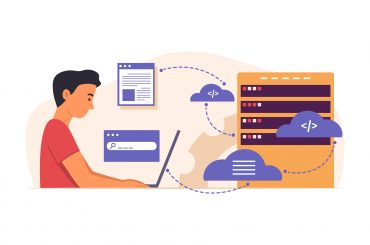Using GraphQL with Shopify – Best Practices
Last Updated | January 16, 2024
Table of Contents
GraphQL is a versatile, useful, and enhanced tool for developers to develop and integrate. Especially with Shopify, as it uses RESTful API by default, which means if your store gets large, it will get difficult to maintain a fast speed. Hence graphQL is always preferred over other API structures.
In this blog, we will explain the uses, benefits, Shopify graphQL best practices, and reasons to switch to graphQL for your Shopify store.
- Nearly 47.9% of the developers use graphQL as their main API environment for their portfolios.
- Nearly 60%+ people connect to graphQL via websites, while 30 percent of the people connect to it via native apps.
- 40% of developers use graphQL for private APIs, which are unexposed.
What Is graphQL?
graphQL is a query language and runtime for APIs. It was developed by Facebook and released as an open-source project in 2015. Shopify graphQL API differs from traditional REST APIs in several ways, including its ability to handle complex data relationships and its ability to allow developers to specify the data they need rather than receiving an entire data set.
Read Also Shopify Variant Metafields
How Does graphQL Work?
graphQL works by using a single endpoint for all API requests. The endpoint is specified in the API definition, which is written in the graphQL language. The client specifies the data it needs in a query, which is sent to the API endpoint. The API returns only the data specified in the query, reducing the amount of data that needs to be transmitted over the network.
Climbing the Shopify Ladder – Empower Your eCommerce with GraphQL Best Practices
Why Use graphQL in Shopify Development?
In order to understand Shopify graphQL best practices, we have to understand the reasons to shift from RESTful API to graphQL in Shopify:
Limited Data Fetching In Shopify
Data fetching has limited ends in the RESTful API, which Shopify uses by default. This can frequently lead to either an over-fetching or under-fetching of data. In contrast, graphQL API Shopify allows users to define the data they need narrowly.
Read Also What is Shopify App Blocks
This eliminates the need to make multiple API calls to retrieve related data and reduces the amount of data transferred between the server and the client. Since network latency and bandwidth usage are both reduced; as a result, performance and scalability are enhanced.
Improved Versioning And Backward Compatibility
Versioning can be difficult in a RESTful API because changing the API in any way, such as adding or removing fields, may cause existing clients who rely on the API to stop functioning properly.
On the other hand, the strongly-typed schema of graphQL Shopify API makes it much simpler to evolve the API over time without causing existing clients to become inoperable. Clients can make API calls with self-assurance that the data they receive conforms to the expected schema, and Shopify developers can add or remove fields from the API without breaking it for their users.
The cost of upgrading the API is reduced, and maintainability is improved.
Read Also Customize Cart Page Shopify
Simplified Client-Side Code
It is common for clients of a RESTful API to need to make multiple API calls and perform complex data transformations before they can successfully retrieve and display data.
However, graphQL’s fragments and nested queries make it possible for clients to specify complex data requirements in a single request, thereby reducing the need for client-side code to manage multiple API calls and data transformations.
This improves developer productivity and shortens the time it takes to release new features by streamlining client-side development and decreasing the likelihood of errors.
Read Also Shopify Website Accessibility Guidelines
Optimized For Real-Time Updates
When using an e-commerce platform like Shopify Plus, it’s crucial to have access to up-to-the-moment data in order to enhance the shopping experience for customers and streamline stock management.
Customers can subscribe to graphQL to get instant notifications whenever certain data changes, like when an order is placed or when stock is replenished.
This feature is essential for e-commerce platforms like Shopify, where real-time updates can improve the customer experience and reduce inventory management overhead.
Improved Documentation And Testing
graphQL’s self-documenting nature makes it easier for developers to understand the API and write accurate tests. The schema and query language provide a clear contract between the server and the client, reducing the likelihood of miscommunication or misunderstanding.
Read Also What is Shopify Polaris
This leads to improved collaboration and faster feedback cycles, reducing the cost of developing and maintaining the API. Additionally, graphQL’s introspection feature allows developers to explore the API and its data types at runtime, improving debugging and troubleshooting.
Best Practices of graphQL for Shopify
When it comes to developing graphQL APIs for Shopify, there are several best practices to follow to ensure that your application is scalable, maintainable, and performant. Here are some of the best practices to keep in mind:
Use the Shopify Admin API graphQL
The Shopify Admin API graphQL is a powerful tool for building Shopify apps. It provides a single endpoint for accessing Shopify data and makes it easy to retrieve the data you need.
Use the Shopify Admin API graphQL Explorer
The Shopify Admin API graphQL Explorer is a great tool for testing and exploring the Shopify Admin graphQL API. It allows you to experiment with queries and mutations and see the results in real time.
Use Pagination For Large Datasets
When querying large datasets, it’s important to use pagination to reduce the amount of data returned in each request. This can improve performance and reduce the load on the server.
Use Caching
Caching is an effective way to improve performance and reduce the load on the server. By caching frequently accessed data, you can reduce the number of requests to the server and improve the overall performance of your application.
Use Batching For Multiple Queries
While making multiple queries, it’s best to batch them together to reduce the number of requests to the server. This can help improve performance and reduce the load on the server.
Use Input Types For Mutations
If you are performing mutations, it’s best to use input types to specify the data to be updated. This can help improve the readability and maintainability of your code.
Read Also Shopify Variants Limit
Use Descriptive Field Names
When designing your schema, it’s important to use descriptive field names that accurately reflect the data they represent. This can help make your schema more understandable and maintainable.
Use graphQL Subscriptions
graphQL subscriptions allow you to subscribe to real-time updates to data in your Shopify store. This can be useful for building real-time applications such as chat apps or notification systems.
Hire a Shopify Development Company
If you want to automate the graphQL integration within Shopify, then opting for a Shopify development services can be highly beneficial. They can provide expertise in Shopify theme customization, app development services, and custom Shopify development.
Moreover, in order to apply graphQL functionality to the front end, we would also suggest opting for a Shopify theme development company to streamline the whole API shifting process easy.
Hire a Shopify Expert
If you need help with a specific aspect of your project, such as graphQL development, it’s best to hire Shopify expert who has experience in that area. They can provide guidance and help ensure that your project is successful!
If you hire Shopify designer then you can get timely monthly Shopify maintenance services. Moreover, all the Shopify integration can be quite fast as well due to the usage of graphQL and in-house Shopify developers.
Benefits of graphQL on Shopify
Following are the benefits that you can achieve after applying Shopify graphQL best practices:
Improved Performance
Especially when working with complex data structures, graphQL can help your app run more efficiently by allowing you to make a single request to retrieve all the data you need. To illustrate, say you need to retrieve a customer’s name, email address, order history, product name, price, and stock level.
That’s right; all you need to do is make one graphQL query to get this information. Thus, load times can be decreased, and user satisfaction can be increased by reducing the number of data requests.
Flexible API
graphQL’s adaptable API lets you query many different resources with a single query. Thus, the number of requests necessary to retrieve the necessary data can be reduced by combining data retrieval from multiple resources into a single request.
For example, you need to retrieve the name, price, and total sales of a single product. In that case, you can make a single graphQL query to collect this information from various sources. Working with complex data structures becomes less laborious, and the number of data retrieval requests is cut down.
Better Developer Experience
graphQL simplifies the management of complex data structures by providing a streamlined query language, comprehensive Shopify graphQL API documentation, and a straightforward schema.
This makes it simple for programmers to learn about the data and how to put it to use. Developers, for instance, can easily grasp the connections between resources and how to query them with a well-designed graphQL schema.
To further aid developers in comprehending the data at hand, graphQL provides extensive documentation outlining the meaning of each field and its relationship to others.
Further, You can limit your search to only the information you need, such as the name, price, and image URL for a specific product. You can also Shopify graphQL create product queries to improve your app or website’s data usage.
Future-Proof
graphQL allows you to easily update your API as your business and data requirements change without impacting your current apps. You can easily adapt to shifting business needs by adding new fields and types to your schema without breaking existing queries.
Read Also How To Edit The Shopify Checkout Page?
As a result, you can update your API without worrying about breaking any of your current applications, which can help you save time and avoid mistakes. Since graphQL has a built-in type system, it’s less of a hassle to update and improve your API as needed to meet the changing demands of your business.
How To Use graphQL in Shopify Development
Shopify offers a graphQL API that you can use to interact with your store’s data. To use graphQL in your Shopify development, you’ll need to perform the following steps:
- Get an API key: To access the Shopify graphQL API, you’ll need an API key for your store. You can generate an API key from the Shopify Admin in the “Apps” section.
- Make a query: You’ll use graphQL to specify the data you want to retrieve from the API. For example, you can query for information about a specific product or organize all products in your store.
- Send the query: To send your query to the API, you’ll need to use a client that supports graphQL. Some popular options include curl, postman, and graphQL-request.
- Parse the response: The API will respond to your query with a JSON object that contains the requested data. You’ll need to parse the JSON object in order to access the data in your application.
Read Also Bigcommerce GraphQL Explorer
Here’s a simple example of a graphQL query to retrieve the title of all products in a Shopify store:
query {
products {
edges {
node {
title
}
}
}
}
This is just a starting point. You can find more information on using the Shopify graphQL API, including a reference of available query fields, in the Shopify API documentation.
Conclusion
graphQL is a powerful tool for Shopify development, allowing developers to handle complex data, and improving better user experience.
Whether you’re a Shopify developer or just starting with graphQL, this technology is worth exploring. Hit us up to apply Shopify graphQL best practices for increasing your site’s capabilities.










